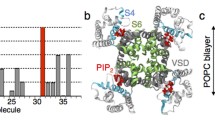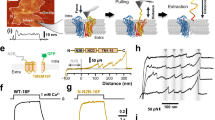Abstract
The aim of the present study is to explore whether membrane targeting of K+ channel-interacting protein 1 (KChIP1) is associated with its EF-hand motifs and varies with specific phospholipids. Truncated KChIP1, in which the EFhands 3 and 4 were deleted, retained the α-helix structure, indicating that the N-terminal half of KChIP1 could fold appropriately. Compared with wild-type KChIP1, truncated KChIP1 exhibited lower lipid-binding capability. Compared with wild-type KChIP1, increasing membrane permeability by the use of digitonin caused a marked loss of truncated KChIP1, suggesting that intact EF-hands 3 and 4 were crucial for the anchorage of KChIP1 on membrane. KChIP1 showed a higher binding capability with phosphatidylserine (PS) than truncated KChIP1. Unlike that of truncated KChIP1, the binding of wild-type KChIP1 with membrane was enhanced by increasing the PS content. Moreover, the binding of KChIP1 with phospholipid vesicles induced a change in the structure of KChIP1 in the presence of PS. Taken together, our data suggest that EF-hands 3 and 4 of KChIP1 are functionally involved in a specific association with PS on the membrane.
Similar content being viewed by others
Abbreviations
- ANS:
-
8-Anilino-1-naphthalene sulphonic acid
- BSA:
-
bovine serum albumin
- CD:
-
circular dichroism
- DMEM:
-
Dulbecco modified Eagle medium
- ELISA:
-
enzyme-linked immunosorbent assay
- FTIR:
-
Fourier transform infrared
- GCAP:
-
guanylyl cyclase-activating protein
- GFP:
-
green fluorescent protein
- HRP:
-
horseradish peroxidase
- KChIP:
-
K+ channel-interacting protein
- MLV:
-
multilamellar large vesicles
- NCS:
-
neuronal calcium sensor
- ORF:
-
open reading frame
- PA:
-
phosphatidic acid
- PC:
-
phosphatidylcholine
- PCR:
-
polymerase chain reaction
- PE:
-
phosphatidylethanolamine
- PI:
-
phosphatidylinositol
- PMSF:
-
phenylmethylsulphonyl fluoride
- PS:
-
phosphatidylserine
References
Ames J B, Ishima R, Tanaka T, Gordon J I, Stryer L and Ikura M 1997 Molecular mechanics of calcium-myristoyl switches; Nature (London) 389 198–202
Ames J B, Hendricks K B, Strahl T, Huttner I G, Hamasaki N and Thorner J 2000 Structure and calcium-binding properties of Frq1, a novel calcium sensor in the yeast Saccharomyces cerevisiae; Biochemistry 39 12149–12161
Barth A and Zscherp C 2002 What vibrations tells us about proteins; Q. Rev. Biophys. 35 369–430
Burgoyne R D, O’Callaghan D W, Hasdemir B, Haynes L P and Tepikin A V 2004 Neuronal Ca2+-sensor proteins: multitalented regulators of neuronal function; Trends Neurosci. 27 203–209
Chang L S, Chen C Y and Wu T T 2003 Functional implication with the metal-binding properties of KChIP1; Biochem. Biophys. Res. Commun. 311 258–263
Chang L S, Lin S R and Chang C C 1996 The essentiality of calcium ion in the enzymatic activity of Taiwan cobra phospholipase A2; J. Protein Chem. 15 701–707
Desmeules P, Penney S E, Desbat B and Salesse C 2007 Determination of the contribution of the myristoyl group and hydrophobic amino acids of recoverin on its dynamics of binding to lipid monolayers; Biophys. J. 93 2069–2082
Freites J A, Tobias D J, von Heijne G and White S H 2005 Interface connections of a transmembrane voltage sensor; Proc. Natl. Acad. Sci. USA 102 15059–15064
Jeromin A, Muralidhar D, Parameswaran M N, Roder J, Fairwell T, Scarlata S, Dowal L, Mustafi S M, Chary K V and Sharma Y 2004 N-terminal myristoylation regulates calcium-induced conformational changes in neuronal calcium sensor-1; J. Biol. Chem. 279 27158–27167
Kao P H, Chen K C, Lin S R and Chang L S 2008 The structural and functional contribution of N-terminal region and His-47 on Taiwan cobra phospholipase A2; J. Pept. Sci. 14 342–348
Lazo N D and Downing D T 2001 Effect of Na2SO4 on hydrophobic and electrostatic interactions between amphipathic α-helices; J. Pept. Res. 58 457–463
Lemmon M A 2008 Membrane recognition by phospholipidsbinding domains; Nat. Rev. Mol. Cell Biol. 9 99–111
Lin L, Braunewell K H, Gundelfinger E D and Anand R 2002 Functional analysis of calcium-binding EF-hand motifs of visininlike protein-1; Biochem. Biophys. Res. Commun. 296 827–832
Long S B, Campbell E B and MacKinnon R 2005 Voltage sensor of Kv1.2: structural basis of electromechanical coupling; Science 309 903–908
McLaughlin S and Aderem A 1995 The myristoyl-electrostatic switch: a modulator of reversible protein-membrane interactions; Trends Biochem. Sci. 20 272–276
Morohashi Y, Hatano N, Ohya S, Takikawa R, Watabiki T, Takasugi N, Imauzumi Y, Tomita T and Iwatsubo T 2002 Molecular cloning and characterization of CALP/KChIP4, a novel EF-hand protein interacting with presenilin 2 and voltage-gated potassium channel subunit Kv4; J. Biol. Chem. 277 14965–14975
O’Callaghan D W, Hasdemir B, Leighton M and Burgoyne R D 2003 Residues within the myristoylation motif determine intracellular targeting of the neuronal Ca2+ sensor protein KChIP1 to post-ER transport vesicles and traffic of Kv4 K+ channels; J. Cell Sci. 116 4833–4845
Park J B, Kim H J, Ryu P D and Moczydlowski E 2003 Effect of phosphatidylserine on unitary conductance and Ba2+ block of the BK Ca2+-activated K+ channel: re-examination of the surface charge hypothesis; J. Gen. Physiol. 121 375–397
Peitzsch R M and McLaughlin S 1993 Binding of acylated peptides and fatty acids to phospholipid vesicles: pertinence to myristoylated proteins; Biochemistry 32 10436–10443
Pioletti M, Findeisen F, Hura G L and Minor D L Jr 2006 Three-dimensional structure of the KChIP1-Kv4.3 T1 complex reveals a cross-shaped octamer; Nat. Struct. Mol. Biol. 13 987–995
Pool C T and Thompson T E 1998 Chain length and temperature dependence of the reversible association of model acylated proteins with lipid bilayers; Biochemistry 37 10246–10255
Resh M D 1999 Fatty acylation of proteins: new insights into membrane targeting of myristoylated and palmitoylated proteins; Biochim. Biophys. Acta 1451 1–16
Scannevin R H, Wang K, Jow F, Megules J, Kopsco D C, Edris W, Carroll K C, Lu Q, Xu W, Xu Z, Katz A H, Olland S, Lin L, Taylor M, Stahl M, Malakian K, Somers W, Mosyak L, Bowlby M R, Chanda P and Rhodes K J 2004 Two N-terminal domains of Kv4 K+ channels regulate binding to and modulation by KChIP1; Neuron 41 587–598
Senin I I, Churumova V A, Philippov P P and Koch K W 2007 Membrane binding of the neuronal calcium sensor recoverin — modulatory role of the charged carboxy-terminus; BMC Biochem. 8 24
Stephen R, Bereta G, Golczak M, Palczewski K and Sousa M C 2007 Stabilizing function for myristoyl group revealed by the crystal structure of a neuronal calcium sensor, guanylate cyclase-activating protein 1; Structure 15 1392–1402
Van Meer G, Voelker D R and Feigenson G W 2008 Membranelipids: where they are and how they behave; Nat. Rev. Mol. Cell Mol. 9 112–124
Vogel A, Schröder T, Lange C and Huster D 2007 Characterization of the myristoyl lipid modification of membrane-bound GCAP-2 by 2H solid-state NMR spectroscopy; Biochim. Biophys. Acta 1768 3171–3181
Wang H, Yan Y, Liu Q, Huang Y, Shen Y, Chen L, Chen Y, Yang Q, Hao Q, Wang K and Chai J 2007 Structural basis for modulation of Kv4 K+ channels by auxiliary KChIP subunits; Nat. Neurosci. 10 32–39
Xu Y, Ramu Y and Lu Z 2008 Removal of phospho-head groups of membrane lipids immobilizes voltage sensors of K+ channels; Nature (London) 451 826–829
Author information
Authors and Affiliations
Corresponding author
Rights and permissions
About this article
Cite this article
Liao, YS., Chen, KC. & Chang, LS. Functional role of EF-hands 3 and 4 in membrane-binding of KChIP1. J Biosci 34, 203–211 (2009). https://doi.org/10.1007/s12038-009-0024-4
Received:
Accepted:
Published:
Issue Date:
DOI: https://doi.org/10.1007/s12038-009-0024-4




